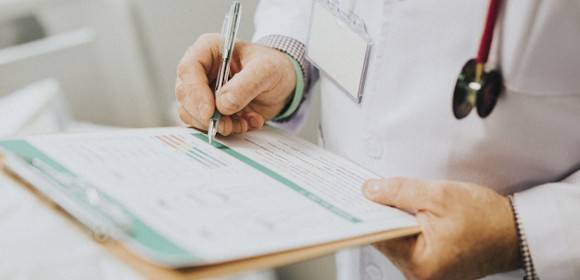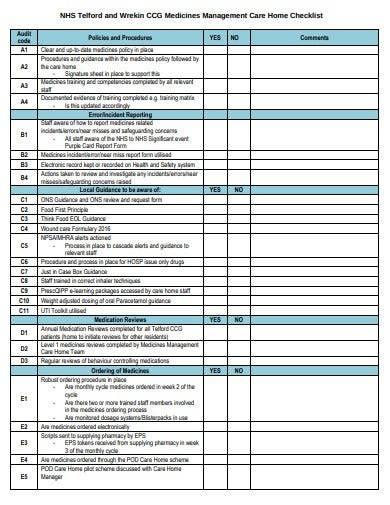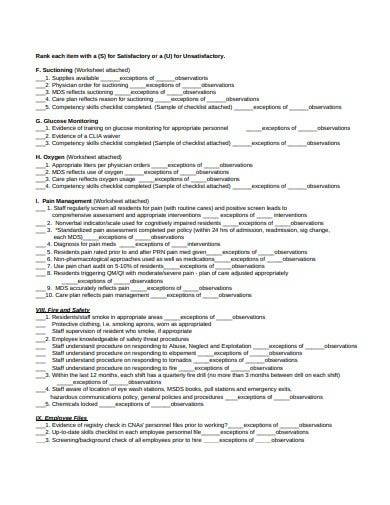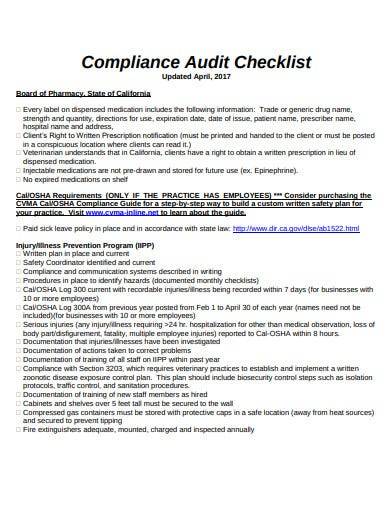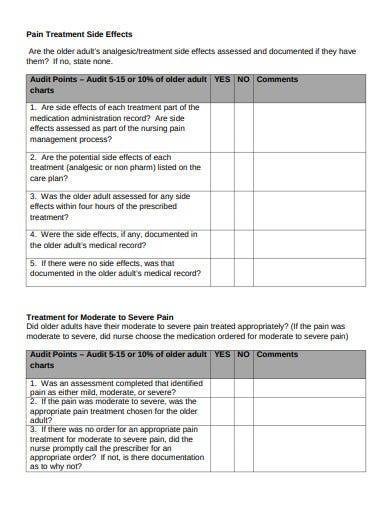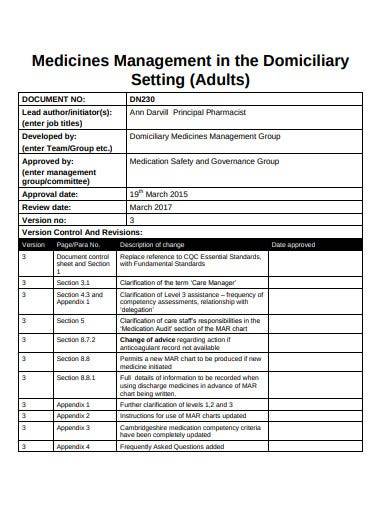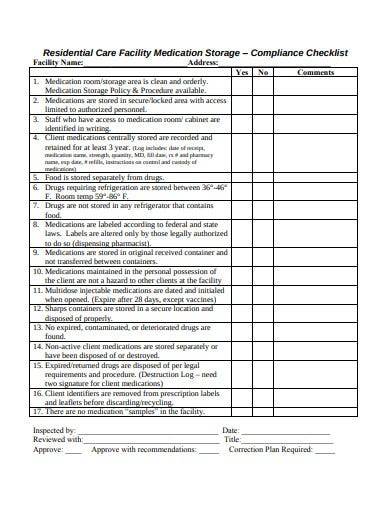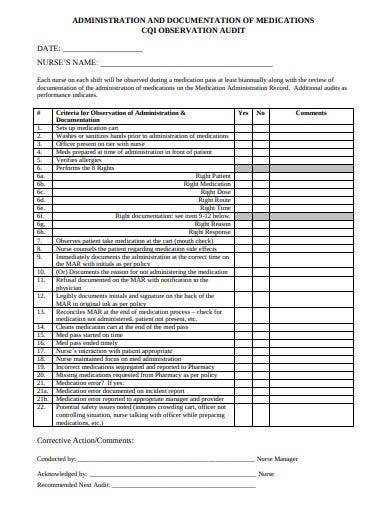Nurses and doctors alike tend to a lot of patients in the hospital. The ideal nurse-to-patient ratio in the emergency department is 1:4 or fewer. Sadly, this rule is seldom followed in hospitals because of the lack of staffing resources. The ratio is even worse when it comes to the staffing in hospital wards. To address the problem, nurses resort to medication checklists to help them get through their shifts. Why are medical checklists important? This article will answer that question and provide you more details about medication checklists. Downloadable samples are also provided for your reference.
FREE 10+ Medication Checklist Samples
1. Medication Checklist Template

2. Daily Medication Checklist Template

3. Medication Audit Checklist Template
4. Medication Chart Audit Checklist
5. Medicines Management Care Home Checklist
6. Formal Medication Audit Checklist
7. Compliance Audit Checklist Template
8. Medication Treatment Audit Checklist
9. Sample Medicines Management Checklist
10. Medication Storage Audit Checklist
11. Administration Medications Audit Checklist
What Is a Medication Checklist?
A medication checklist is a tool used by nurses and other medical professionals to help them carry out medication administration orders from doctors. Part of the nursing care provided to each hospital patient is to ensure the administration of the right medication at the right time. The task seems easy provided that each patient only has one or two medication prescriptions with a nurse-to-patient ratio of 1:2 or fewer. However, a patient may receive more than a dozen medications, depending on their condition. This makes it hard for nurses to remember them all. That is why they regard a medication checklist as a life-saving tool.
Other medical professionals also use a medication checklist to record medication information, document tracking, and medication audit. Patients get discharge medications and follow up doctor’s appointments before they leave the hospital premises. They are given a ‘My Medication List,’ and a medication sheet sample as a guide after the nurse on duty instructs them on what to do. In case a patient experiences unwanted adverse reactions or allergies, medication discontinuation instructions are also provided.
How To Make a Medication Checklist
Although a medication checklist is a highly-regarded tool by medical professionals, it’s actually just a plain and straightforward document. Since most nurses use it as a personal guide, there is no need to follow strict guidelines or formatting. Everything is according to the user’s preferences. But if you need a little help, we’ve prepared here steps to get you started.
1. Prepare the Needed Checklist Template
Before reporting for your shift, make sure to have with you a checklist template for recording patient medication. It does not have to be a standard medication record list, as long as you find it easy to use. If the hospital provides a medication checklist for everybody’s use, then it would be best to use it. If not, you can find a lot of blank checklist templates online that you can download for free.
2. Look for the Patient’s Chart
Get the patient’s chart at the nurse station. Make sure to get only the chart of your own patient so that you won’t make mistakes with the medication to administer. Check the patient’s name on the chart cover, as well as the name on the medication order sheet. This way, you can ensure that you won’t make any medication errors.
3. Copy the Patient’s Prescribed Medication
Once you get hold of your patient’s chart, read the prescribed medications carefully. Take note of the doctor’s order, the date of prescription, the dosage, the frequency of administration, the start and end date, the number of medications ordered, etc. Every detail is important, so if you think that you should take note of it, go ahead and do so. Go over your list to ensure that you have everything recorded correctly. You may also include medication information, like effects and adverse reactions on the checklist.
4. Properly Chart Administered Medication
After administering the medications, make sure to record them in the correct patient’s chart. It is critical that you do this within your shift or before you end your shift so that the next staff will know what medications the patient received under your care.
5. Always Change Your Checklist Daily
The patient’s medication can change depending on their health condition. Medications get added or discontinued throughout the day. That is why you should make a new medication checklist regularly, just like you would with a >daily checklist. This is one way to avoid medication administration errors.
FAQs
What should you include in a medication checklist?
For a complete medication checklist, you should include the following information on your template:
- Name of drug (generic and brand name)
- Drug or medication dosage (including the route of intake, what the drug is treating, side effects to look for, etc.)
- Instructions on how and when to take the medication
- Over-the-counter medications
- Vitamins and other supplements
- Patient drug allergies
- Recently completed prescriptions
- Prescribing doctor
- Name and contact information of pharmacy that filled the prescription
What are the other uses of a medication checklist?
- The medication checklist serves as a guide to new medical practitioners and interns.
- It helps to maintain medical safety and prevent drug administration errors that can put the patient’s life at risk.
- It guides medical practitioners on what to do when administering new and unfamiliar medications.
Just because the tool is easy to use doesn’t mean that you can take it lightly. Human error is the number reason why there are still drug administration errors despite the use of medication checklists. It is the duty of every medical professional to ensure medication administration safety, which can be done simply by paying attention to what they are doing.
Related Posts
FREE 17+ Survey Checklist Samples in MS Word | Google Docs | PDF
FREE 18+ Background Checklist Samples in MS Word | Google Sheets | PDF
FREE 18+ Facilitator Checklist Samples in MS Word | Google Sheets | PDF
FREE 18+ Complaint Checklist Samples in MS Word | Google Sheets | PDF
FREE 18+ Internship Checklist Samples in MS Word | Google Docs | PDF
FREE 18+ Statement Checklist Samples in MS Word | Google Sheets | PDF
FREE 20+ Voluntary Checklist Samples in MS Word | Google Sheets | PDF
FREE 18+ Summary Checklist Samples in MS Word | Google Sheets | PDF
FREE 14+ Sponsorship Checklist Samples in MS Word | MS Excel | PDF
FREE 18+ Conference Checklist Samples in MS Word | Google Sheets | PDF
FREE 17+ Lesson Checklist Samples in MS Word | Google Sheets | PDF
FREE 18+ Progress Checklist Samples in MS Word | Google Docs | PDF
FREE 18+ Enrollment Checklist Samples in MS Word | Google Docs | PDF
FREE 18+ Graduation Checklist Samples in MS Word | Google Sheets | PDF
FREE 15+ Consent Checklist Samples in MS Word | Google Sheets | PDF
